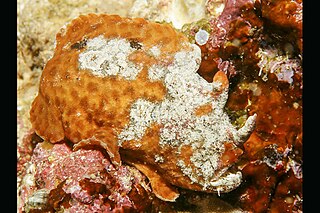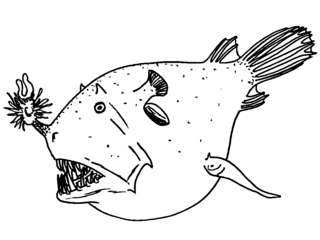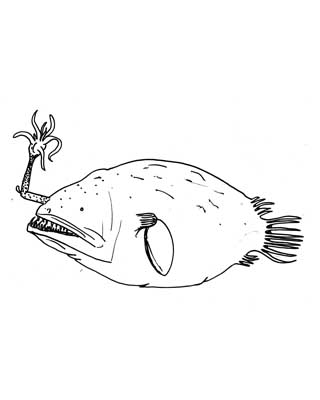
Fanfins or hairy anglerfish are a family, Caulophrynidae, of marine ray-finned fishes within the order Lophiiformes, the anglerfishes. The fishes in this family are found almost around the world in the deeper, aphotic waters of the oceans.

Haplophryne mollis, the ghostly seadevil or soft leftvent angler, is a species of anglerfish in the family Linophrynidae and is the only species in the genus Haplophryne. It is found in the bathypelagic and mesopelagic zones of tropical and subtropical parts of the world's oceans at depths down to about 2,250 m (7,400 ft).
Bertella is a monospecific genus of marine ray-finned fish belonging to the family Oneirodidae, the dreamers, a family of deep sea anglerfishes. The only species in the genus is Bertella idiomorpha and this can be distinguished from other members of the family by the structure of its hyomandibular bone.

Tyrannophryne is a monospecific genus of marine ray-finned fish belonging to the family Oneirodidae, the dreamers, a family of deep-sea anglerfishes. The only species in the genus is Tyrannophryne pugnax, the tyrant devil. Like other oneirodids, T. pugnax is a bathypelagic fish with a bioluminescent lure. It is known only from two adolescent female specimens, one caught in 1928 near Tahiti-Rarotonga, and the other in 1956 northwest of Bikini Atoll.

Lophiocharon is a genus of marine ray-finned fishes belonging to the subfamily Histiophryninae in the family Antennariidae, the frogfishes. These fishes are found in the eastern Indian Ocean and Western Pacific Ocean.

Phyllophryne is a monospecific genus of marine ray-finned fish belonging to the subfamily Histiophryninae in the family Antennariidae, the frogfishes. The only species in the genus is Phyllophryne scortea, the white-spotted anglerfish, smooth anglerfish or smooth frogfish, which is endemic to southern Australia.

Acentrophryne is a genus of deep-sea anglerfish in the family Linophrynidae, the leftvents, known from the eastern Pacific Ocean. Fossils of the type species, A. longidens, have been found in Late Miocene-aged Puente Formation of Rosedale, California.

Borophryne apogon, the netdevil or greedy seadevil, is a species of leftvent anglerfish known today from the waters of the eastern Pacific Ocean off the Central American coast. It is found at depths down to around 1,750 m (5,700 ft). This species grows to a length of 8.3 centimetres (3.3 in) TL. A fossil specimen of this species has been found in the Los Angeles Basin dating back to the Late Miocene, some eight million years ago.

Chaenophryne is a genus of marine ray-finned fish belonging to the family Oneirodidae, the dreamers, a family of deep-sea anglerfishes. These predatory, deep-sea fishes are found in the tropical and subtropical oceans around the world. Like other deep-sea anglerfishes, they are sexually dimorphic, with the matamorphosed females dwarfing the metamorphosed males. The males are not sexual parasites.
Chirophryne is a monospecific genus of marine ray-finned fish belonging to the family Oneirodidae, the dreamers, a family of deep sea anglerfishes. The only species in the gneus is Chirophryne xenolophus, the longhand dreamer. This species is known from a few locations in the Atlantic and Pacific Oceans.
Ctenochirichthys is a monospecific genus of marine ray-finned fish belonging to the family Oneirodidae, the dreamers, a family of deep sea anglerfishes. The only species in the genus is Ctenochirichthys longimanus is known only from two locations, on in the Atlantic Ocean and the other in the Western Pacific Ocean.

Dermatias is a monospecific genus of marine ray-finned fish belonging to the family Oneirodidae, the dreamers, a family of deep sea anglerfishes. The only species in the genus is Dermatias platynogaster which is known from 4 metamorphosed female specimens collected from 3 widley sparated localities in the Western Pacific Ocean.
Dolopichthys is a genus of marine ray-finned fish belonging to the family Oneirodidae, the dreamers, a family of deep sea anglerfishes. These predatory, deep-sea fishes are found in the tropical and subtropical oceans around the world.

The plainchin dreamarm is a species of marine ray-finned fish belonging to the family Oneirodidae, the dreamers, a family of deep sea anglerfishes. It is the only species in the monospecific genus Leptacanthichthys. This species occurs in the North Atlantic and North Pacific Oceans at depths down to 2,000 m (6,600 ft).
Microlophichthys microlophus, the short-rod anglerfish, is a species of marine ray-finned fish belonging to the family Oneirodidae, the dreamers, a family of deep sea anglerfishes. This anglerfish is found in the deeper waters of the tropical and temperate oceans around the world.
Microlophichthys is a genus of marine ray-finned fish belonging to the family Oneirodidae, the dreamers, a family of deep sea anglerfishes. The species in this genus are found in the tropical and subtropical parts of the Atlantic, Indian and Pacific Oceans.

Pentherichthys is a monospecific genus of marine ray-finned fish belonging to the family Oneirodidae, the dreamers, a family of deep-sea anglerfishes. The only species in the genus is Pentherichthys atratus which is found in the bathypelagic zones of the tropical and subtropical Atlantic, Indian and Pacific Oceans. The males of this species are dwarfed and are not parasitic on the females.

Caulophryne jordani, the fanfin angler, is a species of marine ray-finned fish belonging to the family Caulophrynidae, the fanfins. This species is a deepwater species which is found in Oceanic waters around the world. Like other deepwater anglerfishes it shows extreme sexual dimorphism with the males being much smaller than the females and acting as sexual parasites of the females.

Chaenophryne draco, the smooth dreamer, or smooth-headed dreamer, is a species of marine ray-finned fish belonging to the family Oneirodidae, the dreamers, a family of deep-sea anglerfishes. This predatory, deep-sea fish is found in the tropical and subtropical oceans around the world. Like other deep-sea anglerfishes, it is sexually dimorphic, with the matamorphosed females dwarfing the metamorphosed males. The males are not sexual parasites.

Acentrophryne longidens is a species of marine ray-finned fish belonging to the family Linophryidae, the leftvents, a family of deep sea anglerfishes. This species is only known from the eastern Pacific Ocean off the coast of Costa Rica and Panama.














